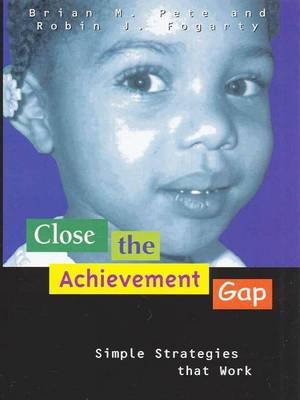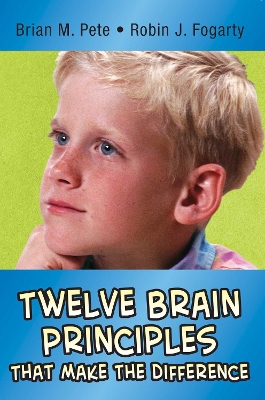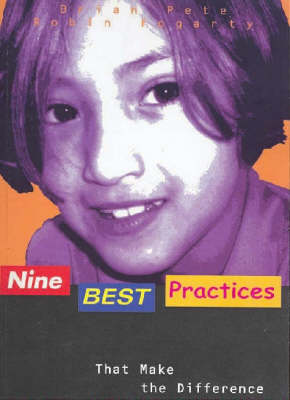In a Nutshell
7 total works
The idea that the person doing the talking is the person doing the learning seems counter-intuitive. Yet, that is exactly the case. When students put their thoughts into words, they internalize the learning. As they dialogue with peers, articulate their ideas, and express themselves, their oral language skills translate directly into written language skills. Explore six strategies that address the challenges of the achievement gap:1) Set High Expectations: Get Kids Emotionally Involved2) Challenges Students to Think: Teach Higher Order Thinking3) Require Rigor: Require Complete Sentences, Standard English, Formal Register4) Leave Nothing to Chance: Revisit! Review! Re-teach! Revise!5) Make No Excuses: Encourage At-Risk Participation6) Insist on Results: Emphasize Reading
Nine Best Practices that Make the Difference
by Brian M Pete and Robin J. Fogarty
Published 1 January 2003
Educators Brian Pete and Robin Fogarty present research-based instructional ideas that encompass an essential repertoire for beginning and developing teachers as they become skilled professionals.
Through a meta-analysis of studies on instructional strategies, they have identified nine families of strategies that significantly increase student achievement. The results of this meta-analysis point educator to a proven pedagogy with teacher-tested, tried-and-true techniques that work to increase student achievement through cognitive and cooperative efforts.
The skills are organized in a 'framework for quality' that includes observable skills in four instructional areas:
This is useful reading for anyone who wants to develop as a teacher.
Through a meta-analysis of studies on instructional strategies, they have identified nine families of strategies that significantly increase student achievement. The results of this meta-analysis point educator to a proven pedagogy with teacher-tested, tried-and-true techniques that work to increase student achievement through cognitive and cooperative efforts.
The skills are organized in a 'framework for quality' that includes observable skills in four instructional areas:
- Creating an Environment for Learning,
- Teaching the Standards of Learning
- Structuring Interactions with Learning,
- Reflecting about the Learning.
This is useful reading for anyone who wants to develop as a teacher.
Twelve Brain Principles That Make the Difference
by Brian M Pete and Robin J. Fogarty
Published 1 January 2003
Here Brian Pete and Robin Fogarty explain how the brain learns best and all the things teachers can do to facilitate the learning part of the teaching scene.
They present a unique organization of Renate and Geoffrey Caine's twelve brain principles. The twelve principles are arranged in four specific quadrants. Each quadrant speaks to a particular aspect of the high-achieving classroom and highlights how instructional decisions are governed by the twelve principles. The Table of Contents:
Part One: Climate for Learning
Challenge/Threat: Learning Principle
Emotions/Cognition: Learning Principle
Focused/Peripheral: Learning Principle
Part Two: Skills of Learning
Parts/Whole: Learning Principle
Spatial/Rote: Learning Principle
Parallel Processing: Learning Principle
Part Three: Interactions With Learning
Physiology: Learning Principle
Brain Uniqueness: Learning Principle
Social/Experience: Learning Principle
Part Four: Learning About Learning
Meaning: Learning Principle
Patterning: Learning Principle
Conscious/Unconscious: Learning Principle
They present a unique organization of Renate and Geoffrey Caine's twelve brain principles. The twelve principles are arranged in four specific quadrants. Each quadrant speaks to a particular aspect of the high-achieving classroom and highlights how instructional decisions are governed by the twelve principles. The Table of Contents:
Part One: Climate for Learning
Challenge/Threat: Learning Principle
Emotions/Cognition: Learning Principle
Focused/Peripheral: Learning Principle
Part Two: Skills of Learning
Parts/Whole: Learning Principle
Spatial/Rote: Learning Principle
Parallel Processing: Learning Principle
Part Three: Interactions With Learning
Physiology: Learning Principle
Brain Uniqueness: Learning Principle
Social/Experience: Learning Principle
Part Four: Learning About Learning
Meaning: Learning Principle
Patterning: Learning Principle
Conscious/Unconscious: Learning Principle
Twelve Brain Principles That Make the Difference
by Robin Fogarty and Brian Pete
Published April 2004






